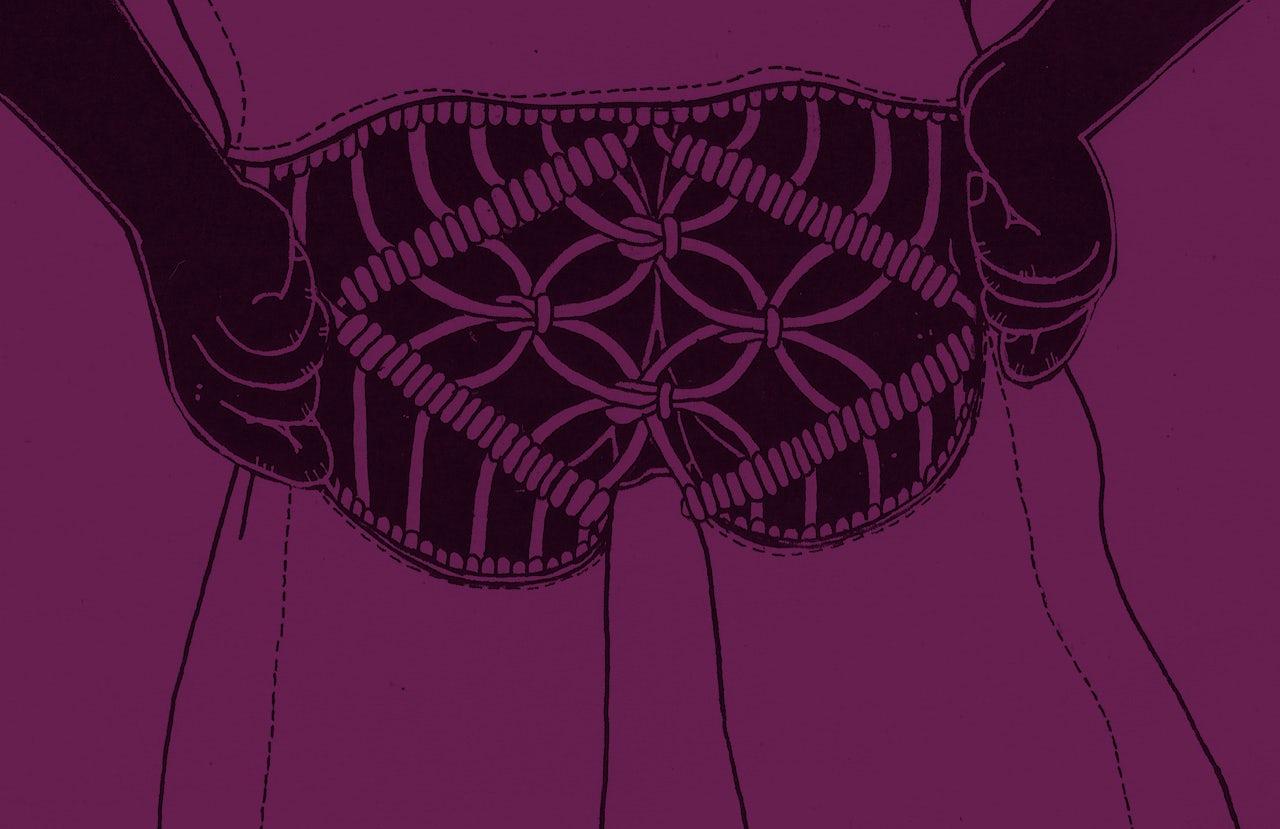In the opening comic of the book Little Stranger, a fanged balloon-like creature with a tail made of the alphabet zips through a maze of bold lines until it reaches a forest of tree-like bodies, enters one, dances, and zips off to a dollar store on what looks to be a flying watermelon. The book only gets weirder, and more inventive, from there. Through his stories and zines of beings in search of identity and form (though the subject of some of the pieces included can’t be nailed down so simply), comic artist, zine maker, and painter Edie Fake's stories focus on communicating experience and feeling rather than linear narratives and passages of time. Now, for the first time, over a decade’s worth of Fake’s underground zines have been collected in this new book, Little Stranger, a compendium of unique visual explorations of non-binary bodies and queer community, as well as abstract feelings and experiences much more difficult to sum up in words.
Having started his career in the Chicago queer and DIY arts communities, Fake moved to California in 2014 to attend the MFA Program at the University of Southern California Roski School of Art. But after he and six other students dropped out to protest rescinded financial support among other depletions of the program, Fake moved to the desert outside of Joshua Tree, where he lives and works today and compiled Little Stranger. The collection has echoes of his 2011 book Gaylord Phoenix, an abstract narrative mythology about a queer creature on a psychedelic journey of self-discovery for which Fake won the 2011 Ignatz Award for Outstanding Graphic Novel. Similar to that work, Little Stranger takes the reader on a fantastical journey warping narrative and comics convention at some times, and doing away with them altogether at others. Made up of Fake’s zines from 2002 to 2017, the pieces in Little Stranger explore a number of drawing styles touching on everything from intricate patterning to vintage advertising, cookbooks, and diagrams. One-off, context-less drawings appear between mini-narratives about approaching the unknown. And while the book doesn’t demand any one story or interpretation, Fake, who is trans, often explores bodies and sexual experience in his zines, embracing the absurdity and fear that surrounds both subjects.
With its fearless embrace of all things pleasurable, weird, and a little scary, Little Stranger, which will be released July 17, offers a unique, visceral reading experience unlike any other comic, graphic novel, or zine I’ve ever read. Fake spoke to The Outline via phone from his home in California to shed a bit more light on his new book and share some of the intention behind his work.
How did you decide to put your zines together in Little Stranger?
My publisher Secret Acres came to me with the idea. At first I was like, there's not enough material, and also thought that it wouldn't make sense together because there's a bunch of different stuff from a bunch of different times. But I think the book came together really nicely as a collection of short stuff. It's all stuff that came out in small press editions, so it's nice to have it all collected in one place instead of a thousand squirrelier places. It [all] makes sense together as some kind of queer sex liminal fantasy, or something.
How did you decide what you wanted to include and how you wanted to put them together?
The order was the most fun because it was kind of like making a mixtape. It was really nice to take a look at the stuff and be like oh there's like this thing that loosely connects this to this and that makes it blend easily one into the other. When we first started putting it together I was like it's all going to be scrambled eggs, nothing's going to fit. And then there's enough threads throughout that I could make it work.
Did you discover these different threads as you were going through or did know the recurring themes that come up in your work?
There's some approaches I have to making comics that revolve around a similar theme. There were elements that I knew were entrance points for me to make a comic. Like, I'll base some of the character design on like Halloween decorations because I think it is a funny way to access something that's kind of goofy but referencing something scary, and there are just weird beautiful bodies. [I’m] also trying to get the comics to touch either a strange experience or something that I can't quite remember but feel on an emotional level.
And they're not in any sort of chronological order.
Yeah, not really. The book came together more around scenes than around what goes where on a timeline. That's interesting, too, because I can see my thoughts cycling back onto things.
Instead of looking at your work in this linear way.
Yeah, totally, and being like 2002 was like this, 2003 was like that. There's definitely stuff that's much looser, zines that were little illustrations or no narrative, and I'd say almost all that stuff is earlier. I draw this narrative comic Gaylord Phoenix, and when I was between making issues of that I would try and play around with stuff that was based on a single story and more emotional drawings, for lack of a better word.
Your paintings were recently featured in the Paris Review. In your zines you explore bodies and depiction of bodies more. But in your paintings it seems like you focus more on place making and spaces and architecture. Is that fair?
Yeah, absolutely. And [in] my drawing process, if I have an idea and it's pushing to be something that's more narrative I'll probably approach it in a sequential way like a comic or a zine. The paintings seem like ideas that I have less of a narrative grasp on. Paintings can talk about bodies and history and queer identity in this way that they try to push a lot into a single image. Especially stories about or thinking about bodies and vulnerability and sexuality, my mind has a much more narrative take on that, and so I tend [to approach those in] little books. I also like that zines are more of an intimate format. I try and play it by ear, what my ideas tend more towards, and then follow that star to make what I think best suits the way I'm thinking about things. It goes back and forth, too. It's nice to have different approaches.
In some of these zines, there's a you character.
Yeah, [with Gaylord Phoenix] people kept asking if I was the character in that series, and I was like well kind of, of course, but it's also a psychedelic fantasy so also not. But drawing myself in the comic[s] almost started as a thought experiment. What if I really was a blatant character in it? I keep doing it because it seems like it is like a powerful approach to making comics. I don't have a really good grasp on making something that would be straight up autobiographical. But I do feel like I'm really interested in portraying trans bodies in the comics and also trying to work in the way a body feels, a visceral kind of examination of my own body and sexuality. They're almost like horror fantasy or something.
Yeah, there's so much in Gaylord Phoenix that is really playful. Little Stranger has that, too, but there's also more frightening imagery around the change and morphing of bodies.
The scripting of all of these starts out super loose and almost dream-like, and then I try and hone it into something that feels really like a story that seems very honest to me. And yet at the same time, I have a lot of fury, I guess, and also appreciation of things that are a little uncomfortable or scary. There's more and more language and honesty around trans bodies. But I think there's still these huge gaps in talking about them sexually in a way that's non-binary and affirming. And although some of these stories are gruesome stuff, I almost felt like I had to take the most visceral path to get to to something that was driving me or like something I was dealing with. I have a lot of missing memory and trying to sort through that is part of what these comics are, too, to the point where it's almost like I get really uncomfortable reading them, and I wrote them. I can't read them straight through because they're about something for me that I still can't articulate. But I'm trying to.
You play a lot with panels. Sometimes they're really defined, sometimes they're just one big page, in one they’re windows. What’s the thought process that goes into using comics conventions like panels?
I really have to force myself to use panels, it doesn't come naturally to me. But I also like doing really corny things with panels, like making them into windows or something. There are comics in this book that almost start off with the premise of me forcing myself to learn how to use panels because I never think about that with the pacing of a comic. I'm more interested in them as creating a spatial thing in the comic rather than necessarily moving the timing along, the pacing along, at a certain rate. I'm much more interested in them being windows or doors or a panel being an entire room than it being a moment in time.
You depict bodies in so many different ways. Is that something you’ve explored for a long time?
I do feel like there things that a drawing loses if I just go in for a totally realistic representation of a body. In order to sprinkle it with the gay magic that I know is there, I lean much more into adding something that's fantastical. I'm not afraid to have bodies that transform really quickly or morph or change into other things or have this kind of cosmic erogenous aspects to them.
Do you ever think about the reader when you're making your comics and zines or is it a completely personal process?
I do think about the reader in the way that I want the comics to be most legible to queer bodies and people. Just like anyone, I want to feel seen in the world. I have a transmasculine, non-binary body. I feel like it's more and more represented in culture, but there’s also a lot of missing language for it, in a way. And so my first thoughts of audience are [that] I want [my work] to help contribute to a conversation of queerness. And then if it's entertaining in a general sense that's great, too. I remember when Gaylord came out, there were a lot of reviews of it that were like this book isn't for everybody and I was like, no book is for everybody. When you say a book is for everybody, I'll probably tell you that I hated it.
So who is Little Stranger for?
As the dedication of the book [says], it's for queer weirdos, Queerdoes, and it's specifically for trans and non-binary people, especially. But, yeah, I'm excited if anyone wants to give it a chance and read it.
Hear an audio version of this story and additional thoughts from Edie Fake on The Outline World Dispatch. Listen later on your favorite app or device below.
Pocket Casts / Overcast / Stitcher / TuneIn / Alexa / Anchor / 60 dB / RadioPublic / RSS / “OK Google, play news from The Outline.”













